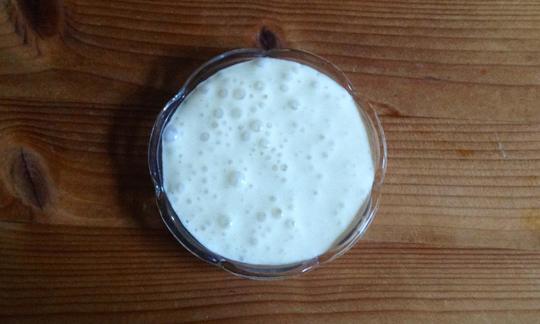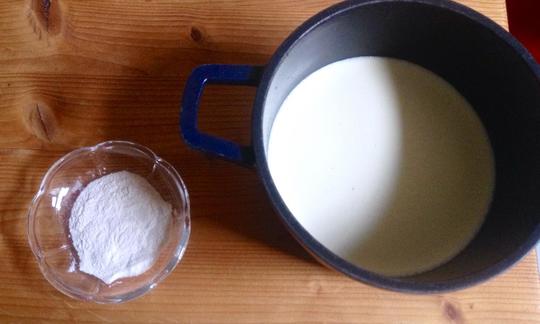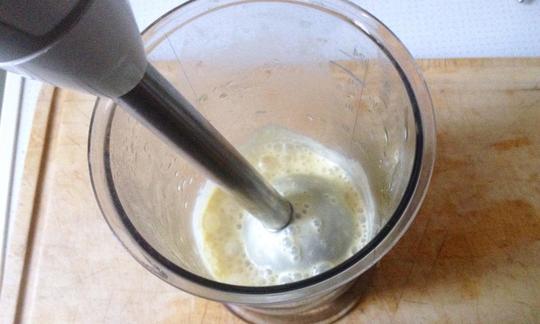Soy Whipped Cream with Agar Agar
vegan
Ingredients (for servings, )
Equipment
- hand-held blender / immersion blender
- whisk
- stove
- saucepan
Type of preparation
- cook
- beat
- bring to a boil
Preparation
Whisk the agar-agar with the soy cream in a small saucepan.
Bring the mixture to a boil and simmer for about 2 minutes. Remove from the heat and let cool.
Make sure that the heat is not too high, since the mixture thickens considerably and can burn at high temperatures. Be sure to keep an eye on the pan.
As soon as the cream has cooled, it is ready to be whipped. Whip until it reaches the desired consistency.
An immersion blender is most efficient for quick and easy whipping, but you can also use an electric mixer. You can also use a whisk, but the whipped cream won’t turn out as well.
|
Nutritional Information per person
Convert per 100g
|
2000 kcal | |
|---|---|---|
| Energy | 388 kcal | 19.4% |
| Fat/Lipids | 40 g | 57.0% |
| Saturated Fats | 3.0 g | 15.0% |
| Carbohydrates (inc.dietary fiber) | 5.8 g | 2.2% |
| Sugars | 3.5 g | 3.8% |
| Fiber | 0.56 g | 2.2% |
| Protein/Albumin | 2.8 g | 5.7% |
| Cooking Salt (Na:44.5 mg) | 113 mg | 4.7% |
| Essential micronutrients with the highest proportions | per person | 2000 kcal | |
|---|---|---|---|
| Fat | Alpha-Linolenic acid; ALA; 18:3 omega-3 | 3.6 g | 179.0% |
| Fat | Linoleic acid; LA; 18:2 omega-6 | 7.7 g | 77.0% |
| Vit | Vitamin E, as a-TEs | 6.8 mg | 57.0% |
| Vit | Vitamin K | 30 µg | 40.0% |
| Prot | Tryptophan (Trp, W) | 0.03 g | 13.0% |
| Min | Copper, Cu | 0.11 mg | 11.0% |
| Min | Manganese, Mn | 0.21 mg | 11.0% |
| Prot | Threonine (Thr, T) | 0.09 g | 10.0% |
| Vit | Folate, as the active form of folic acid (née vitamin B9 and | 18 µg | 9.0% |
| Min | Selenium, Se | 4.2 µg | 8.0% |
Detailed Nutritional Information per Person for this Recipe
The majority of the nutritional information comes from the USDA (US Department of Agriculture). This means that the information for natural products is often incomplete or only given within broader categories, whereas in most cases products made from these have more complete information displayed.
If we take flaxseed, for example, the important essential amino acid ALA (omega-3) is only included in an overarching category whereas for flaxseed oil ALA is listed specifically. In time, we will be able to change this, but it will require a lot of work. An “i” appears behind ingredients that have been adjusted and an explanation appears when you hover over this symbol.
For Erb Muesli, the original calculations resulted in 48 % of the daily requirement of ALA — but with the correction, we see that the muesli actually covers >100 % of the necessary recommendation for the omega-3 fatty acid ALA. Our goal is to eventually be able to compare the nutritional value of our recipes with those that are used in conventional western lifestyles.
| Essential fatty acids | per person | 2000 kcal |
|---|---|---|
| Alpha-Linolenic acid; ALA; 18:3 omega-3 | 3.6 g | 179.0% |
| Linoleic acid; LA; 18:2 omega-6 | 7.7 g | 77.0% |
| Essential amino acids | per person | 2000 kcal |
|---|---|---|
| Tryptophan (Trp, W) | 0.03 g | 13.0% |
| Threonine (Thr, T) | 0.09 g | 10.0% |
| Isoleucine (Ile, I) | 0.10 g | 8.0% |
| Leucine (Leu, L) | 0.16 g | 7.0% |
| Lysine (Lys, K) | 0.11 g | 6.0% |
| Phenylalanine (Phe, F) | 0.10 g | 6.0% |
| Valine (Val, V) | 0.10 g | 6.0% |
| Methionine (Met, M) | 0.02 g | 3.0% |
| Vitamins | per person | 2000 kcal |
|---|---|---|
| Vitamin E, as a-TEs | 6.8 mg | 57.0% |
| Vitamin K | 30 µg | 40.0% |
| Folate, as the active form of folic acid (née vitamin B9 and | 18 µg | 9.0% |
| Pantothenic acid (vitamin B5) | 0.34 mg | 6.0% |
| Thiamine (vitamin B1) | 0.05 mg | 5.0% |
| Vitamin B6 (pyridoxine) | 0.07 mg | 5.0% |
| Riboflavin (vitamin B2) | 0.06 mg | 4.0% |
| Niacin (née vitamin B3) | 0.44 mg | 3.0% |
| Essential macroelements (macronutrients) | per person | 2000 kcal |
|---|---|---|
| Magnesium, Mg | 25 mg | 7.0% |
| Phosphorus, P | 45 mg | 6.0% |
| Sodium, Na | 44 mg | 6.0% |
| Potassium, K | 107 mg | 5.0% |
| Calcium, Ca | 25 mg | 3.0% |
| Essential trace elements (micronutrients) | per person | 2000 kcal |
|---|---|---|
| Copper, Cu | 0.11 mg | 11.0% |
| Manganese, Mn | 0.21 mg | 11.0% |
| Selenium, Se | 4.2 µg | 8.0% |
| Iron, Fe | 0.66 mg | 5.0% |
| Zinc, Zn | 0.13 mg | 1.0% |
Our soy whipped cream recipe, which uses canola oil and agar-agar for texture, offers an alternative to conventional whipped cream. Vegan!
Soy whipped cream: The texture of soy whipped cream makes it a better accompaniment for cakes or other desserts than plain soy cream. It allows people who are lactose intolerant to enjoy whipped cream without worrying about side effects.
Whipped texture: This soy whipped cream will not whip as well as conventional cream. After whipping, you will find that it sets a bit more so that it has a slightly different consistency or texture than conventional whipped cream. It is more like a light whipped cream or a mousse.
Agar-agar: This ingredient is a natural thickener that is extracted from the cell walls of certain species of algae. This property makes agar-agar much like pectin, so it is a good alternative to gelatin for vegetarians and vegans. Like pectin, agar-agar requires heating to develop its binding properties. You can learn even more about agar-agar by reading the information we have provided for this ingredient.
Test your agar-agar: Variations in the agar-agar can affect the final texture of your whipped cream. Since agar-agar products fluctuate in their ability to thicken food, we recommend that you test your agar-agar before you make the whipped cream. You can check its ability to thicken foods by boiling the agar-agar in a little water for at least 2 minutes. When cooled for about 3 minutes, the mixture should have a gel-like consistency; otherwise, you will have to adjust the cooking or cooling time accordingly.
If you make the soy cream base yourself by following the recipe for soy cream, you might want to try one of the alternative preparation suggestions there. Adding vanilla or other spices to your whipped cream will also produce tasty results.












